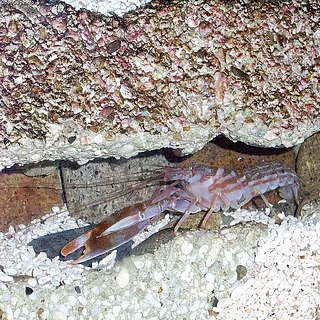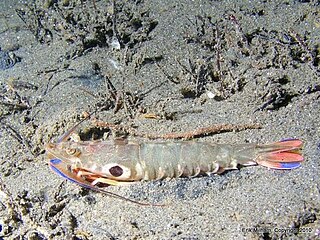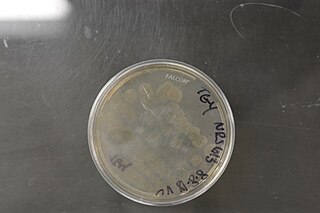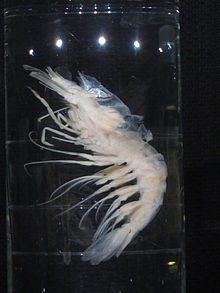
The Decapoda or decapods are an order of crustaceans within the class Malacostraca, and includes crabs, lobsters, crayfish, shrimp, and prawns. Most decapods are scavengers. The order is estimated to contain nearly 15,000 extant species in around 2,700 genera, with around 3,300 fossil species. Nearly half of these species are crabs, with the shrimp and Anomura including hermit crabs, porcelain crabs, squat lobsters making up the bulk of the remainder. The earliest fossils of the group date to the Devonian.

The family Polychelidae contains thirty-eight extant species of blind, benthic lobster-like crustaceans. They are found throughout the world's tropical, sub-tropical and temperate oceans, including the Mediterranean Sea and the Irish Sea.

Penaeidae is a family of marine crustaceans in the suborder Dendrobranchiata, which are often referred to as penaeid shrimp or penaeid prawns. The Penaeidae contain many species of economic importance, such as the tiger prawn, whiteleg shrimp, Atlantic white shrimp, and Indian prawn. Many prawns are the subject of commercial fishery, and farming, both in marine settings, and in freshwater farms. Lateral line–like sense organs on the antennae have been reported in some species of Penaeidae. At 210 metres per second (760 km/h), the myelinated giant interneurons of pelagic penaeid shrimp have the world record for impulse conduction speed in any animal.

Alpheus is a genus of snapping shrimp of the family Alpheidae. This genus contains in excess of 330 species, making this the most species-rich genus of shrimp. Like other snapping shrimp, the claws of Alpheus are asymmetrical, with one of the claws enlarged for making a popping noise. Some species in the genus enter into symbiotic relationships with gobiid fishes, and others associate with sea anemones.

Munidopsis is a genus of squat lobster. It is the second largest of all the genera of squat lobsters, after Munida, with over 200 species. Its members are mainly found on continental slopes and on abyssal plains. A few fossil species are also known, including specimens from the Campanian (Cretaceous).

Metapenaeopsis, the velvet shrimps, is a prawn genus in the family Penaeidae. It contains these species:

Sicyonia is a genus of prawns, placed in its own family, Sicyoniidae. It differs from other prawns in that the last three pairs of its pleopods are uniramous, rather than biramous as seen in all other prawns.

Nephropsis is a genus of lobsters containing 18 extant species:

Ancylomenes is a genus of shrimp, erected in 2010 to accommodate the group of species around "Periclimenes aesopius". Members of the genus are widely distributed in the warm oceans of the world, and live in association with cnidarians; most are cleaner shrimp.

Euryopis is a genus of comb-footed spiders that was first described by Anton Menge in 1868.

Faiditus is a genus of comb-footed spiders that was first described by Eugen von Keyserling in 1884.

Aristeidae is a family of Dendrobranchiata decapod crustaceans known as deep-sea shrimps, gamba prawns or gamba shrimps. Some species are subject to commercial fisheries.

Solenoceridae is a family of decapods, containing 10 genera. Members of this family are marine, inhabiting shallow and offshore waters from the mid-continental shelf, ranging from depths to 1000 meters deep. Members of this family are also sometimes confused with other commercial shrimp species.

Hymenopenaeus is a genus of prawns containing 17 species.

Cytobacillus is a genus of rod-shaped bacteria that stain either Gram-positive or Gram-variable in the family Bacillaceae within the order Bacillales. The type species for this genus is Cytobacillus firmus.
Mesobacillus is a genus of gram-positive or gram-variable, rod-shaped bacteria in the family Bacillaceae within the order Bacillales. The type species for this genus is Mesobacillus jeotgali.
Litchfieldia is a genus of Gram-positive rod-shaped bacteria in the family Bacillaceae within the order Bacillales. The type species for this genus is Litchfieldia alkalitelluris.















